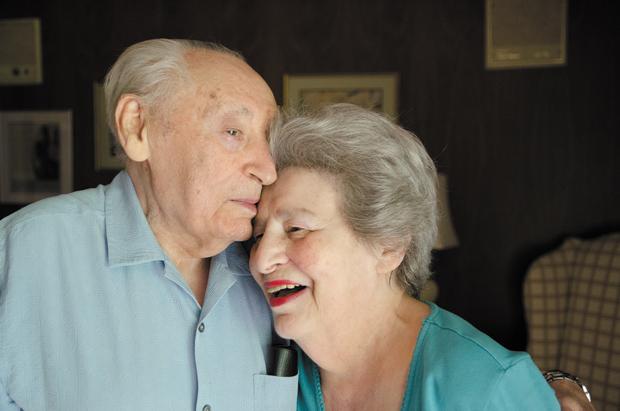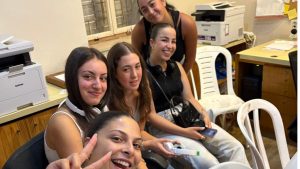HMLC to honor survivors instrumental in museum’s founding
Published July 18, 2012
Ask Leo Wolf how many relatives he lost and the 91-year-old Creve Coeur man returns an answer simple enough to sum up what everybody should know about the Holocaust.
“Enough,” he said.
But thanks to Wolf, whose entire family vanished in the camps of wartime Europe, people know far more about one of history’s darkest and most horrifying chapters and it’s the efforts of he and his wife and fellow survivor Sara to bring that story to thousands in St. Louis which will be honored next month by the Holocaust Museum and Learning Center. The museum will hold a special dinner to recognize the couple Aug. 5 at the Marriott Maryville West.
Wolf was long one of the biggest proponents of the museum’s creation. It’s no mystery why he pushed so hard to commemorate the lives of those taken by the flames of the Shoah.
“I’m a survivor,” he said. “The whole family of mine is gone. I have my wife and kids but no relatives so I thought I should do something.”
‘The bottom day’
For the Wolfs, the nightmare began with an invasion of the couple’s native Poland. The pair knew each other casually before the Nazi onslaught. Sara, now 84, was a child at the time; Leo, a teenager. Soon they found themselves herded into the Lodz Ghetto where, according to the Jewish Virtual Library, more than 230,000 people were imprisoned.
“There was no surprise,” said Leo of the Nazis’ cruelty. “We figured it was going to be rough but it was even worse than we figured.”
Deportations from the ghetto began soon enough, and Leo and Sara each experienced the now infamous cattle cars during a frigid Polish winter. Traveling separately, they eventually arrived at Auschwitz.
“When we get there is when we found out where we are,” he said. “We didn’t even know Auschwitz existed. We had no idea.”
Neither stayed long. Within days, Sara was shipped out, eventually sent to clear forests and, at one point, put to work in a salt mine. She said the conditions were horrifying. Waking up to find out who had passed away during the night of malnutrition or disease was commonplace.
“We used to get up in the morning,” she recalled. “You’d look around and there were dead people.”
She saw people eating anything they could, even poisonous mushrooms from the ground. She credited her survival to support from her sisters and a cousin who were imprisoned with her.
Was there any point that was the worst?
“Every day was the bottom day,” she said solemnly.
Leo also left Auschwitz quickly and went through a long succession of camps, often smaller ones in Bavaria. Twelve-hour workdays were usual. The young man, who was in his 20s, labored at a cement factory for a time. He also cleared forests for the Autobahn (Germany’s “super highway”). Eventually, he wound up in Dachau.
“You could die any minute, not just every day,” he said. “The German with the gun could pull the trigger and I’m gone.”
It was difficult for either of them to maintain hope of a future.
“Sometimes looking back, I think to myself, did I really go through it?” said Sara. “How did I survive?”
Leo became a part of the Dachau Death March into the forest. He survived through some lucky breaks.
“One of the soldiers was a Polish guy from a little village near Lodz,” he said. “He spoke Polish and I spoke to him. He gave me his bread box to carry so I stole some for myself and my friends.”
Death was an ever-present reality through the entire experience. It was hard for him to know he’d come out of it alive.
“At least I didn’t,” he said. “I can’t tell you about the other people. I didn’t know that I was going to make it.”
He almost didn’t. Leo weighed 66 pounds when he was liberated by the Americans. He spent five months in the hospital. When he felt well enough he simply left without telling anyone.
“If they look at the book, they’d probably say I was still there,” he joked.
Sara was also eventually put on a march, this one to Bergen-Belsen as the Allies closed in. She was later liberated by the British who gave them food and chocolate. Some prisoners became ill just from eating after so long without sustenance.
“They weren’t used to food and they were grabbing everything and eating it,” she said.
In the chaos after the camps everyone was looking for relatives and Leo was no exception. He eventually found his way to Bergen-Belsen in search of his kin. None of his family had survived. Instead, he met Sara’s brother and became better acquainted with her. They were married just before arriving in the United States.
Making it happen
Leo Wolf found a new mission after coming to America. He was instrumental in organizing the earliest Yom HaShoah commemorations, a program of which he is still a supporter. As the years went on, he also became a powerful voice and contributor for the construction of what would eventually become the HMLC.
Thomas Green, a former president of the Jewish Federation, noted that there were some 350 to 400 survivors in the area.
“Leo was the head of that group,” he said. “He was always out in front.”
It didn’t come without problems and a degree of resistance. Funding shortages during the Kopolow Building’s construction pushed the project back. Eventually, Leo Wolf, Green and Bill Kahn had to raise cash to put the project in motion.
“We knocked on doors and got appointments with people,” Leo Wolf recalled. “At that time a lot of people said we don’t want any part of it.”
Even once it was moving forward, Green remembered that his friend remained engaged.
“When we were building the museum, Leo went by there every single morning to check on the job,” Green recalled. “He wanted to make sure it was done right.”
Jean Cavender, director of the HMLC, which opened in 1995, said the Wolfs’ contributions have been incredibly important.
“Leo’s story is really interwoven with the museum,” she said, “beginning with the fact that he was in the Lodz Ghetto which we have a replica of.”
That’s not all they have. The original suitcase Wolf had with him when he arrived here is in the collection as well. There is also a photograph of the Dachau march in which Wolf himself appears. He discovered his own presence in the grainy snapshot while on a tour of the U.S. Holocaust Memorial Museum.
“Suddenly, I heard Leo yelling, ‘That’s me! That’s me!’ We didn’t know what he was talking about,” Green remembered. “He had never seen the picture and we had never seen the picture. It was just breathtaking.”
Wolf’s involvement with the HMLC remained after it was built. For many years, he went to schools to speak about his experiences. Wolf said that for some children, his story came as a surprise.
“They didn’t know,” he said. “They knew that there was a war. But that the Jews got that treatment, they didn’t know at all.”
Cavender said such interactions provide a linkage to the past that mere documentation cannot.
“It’s important to have individuals who were eyewitnesses to what happened to be part of a live dialogue with people,” she said. “When any of our survivors give testimony, it’s always important for people to be able to ask questions and understand and realize that this really happened.”
Children can also feel Wolf’s influence through the HMLC itself. Nearly 30,000 come through the institution on school field trips every year.
“Certainly its success has proved Leo right and proved all of us right,” Green said.
The survivor community was certainly grateful. Fellow survivor Mendel Rosenberg said he is happy to attend the event for the Wolfs. In fact, he’s helping to plan it.
“People are involved, people are participating and Leo Wolf did a fantastic job trying to get it started,” he said of the HMLC.














